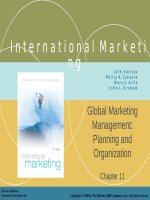Lecture International marketing (15/e): Chapter 3 - Philip R. Cateora, Mary C. Gilly, John L. Graham
Bạn đang xem bản rút gọn của tài liệu. Xem và tải ngay bản đầy đủ của tài liệu tại đây (389.64 KB, 15 trang )
International Marketing
15th edition
Philip R. Cateora, Mary C. Gilly, and John L. Graham
Introduction
• To understand a society’s actions and its points of
view, you need to appreciate:
– The influence of historical events
– The geographical uniqueness to which a culture
has had to adapt
• Culture can be defined as society's accepted basis
for responding to external and internal events
• To interpret a culture’s behavior and attitudes, a
marketer must have some idea of a country’s
history and geography
Roy Philip
2
History Perspective
in Global Business
• History helps define a nation’s mission
– How it perceives its neighbors
– How it perceives itself
– Its place in the world
• Insights into history are important for
understanding current attitudes
• It is necessary to study culture as it is now as
well as to understand culture as it was
– A country’s history
Roy Philip
3
Geography and Global Markets
• Geography – an element of the uncontrollable
environment that confronts every marketer
– Affects a society’s culture and economy
– Physical makeup limits a nation’s ability to supply
its people’s needs
Roy Philip
4
Climate and Topography
• Altitude, humidity, and temperature extremes
– South America
– British resistance of the English Channel
– Trade through the Alps
Roy Philip
5
6
Geography, Nature
and Economic Growth
• As countries prosper, natural barriers are
overcome
• Environmental issues
–
–
–
–
Disruption of ecosystems
Relocation of people
Inadequate hazardous waste management
Industrial pollution
Roy Philip
7
Social Responsibility
and Environmental Management
• Environmental protection is not an optional extra
• Pollution is on the verge of getting completely out of
control
• China has 16 of the world’s 20 most polluted cities
• Critical issue: the disposal of hazardous waste
• Sustainable development
• />
• />
Roy Philip
8
Resources (1 of 2)
• The availability of minerals and the ability to
generate energy are the foundations of modern
technology
• The principal supplements to human energy
–
–
–
–
–
–
–
Animals
Wood
Fossil fuel
Nuclear power
Ocean tides
Geothermal power
The sun
Roy Philip
9
Resources (2 of 2)
• United States in perspective
– 1942 – nearly selfsufficient
– 1950 – major importer
– 19732000 – increased dependency from 36% to
66%
– Mid2000’s – predicted to be importing more than
70% of needs
• The location, quality, and availability of
resources will affect the pattern of world
economic development and trade well into the
21st century
Roy Philip
10
Dynamics of Global
Population Trends
• Global population trends determine today’s demand
for goods
–
–
–
–
Rural/urban population shifts
Rates of growth
Age levels
Population control
• Changes in population will profoundly affect future
demand
• The most important deterrent to population control
is cultural attitudes about the importance of large
families
Roy Philip
11
Controlling
Population Growth
• Procreation is one of the most culturally sensitive
uncontrollable factors
• Perhaps the most important deterrent to
population control is cultural attitudes about the
importance of large families
• Family planning and all that it entails is by far
the most universal means governments use to
control birthrates, but some economists believe
that a decline in the fertility rate is a function of
economic prosperity and will come only with
economic development
Roy Philip
12
Rural/Urban Migration
• Result of a desire for greater access to:
– Sources of education
– Health care
– Improved job opportunities
Roy Philip
13
Population Decline and Aging
• Population growth in many countries has
dropped below the rate necessary to maintain
present levels
• A nation needs a fertility rate of about 2.1
children per woman
• Not one major country has sufficient internal
population growth to maintain itself
Roy Philip
14
Summary
• A prospective international marketer should be
reasonably familiar with the world, its climate,
and topographic differences
• Geographic hurdles must be recognized as having
a direct effect on marketing and the related
activities of communications and distribution
Roy Philip
15









